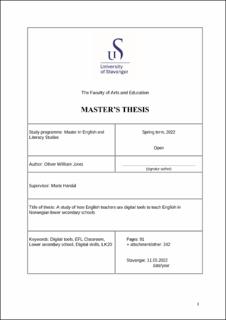A study of how English teachers use digital tools to teach English in Norwegian lower secondary schools
Master thesis
Permanent lenke
https://hdl.handle.net/11250/3002785Utgivelsesdato
2022Metadata
Vis full innførselSamlinger
- Student papers (HF-IKS) [905]
Sammendrag
This study aims to investigate teachers´ use of digital tools in lower secondary Norwegian EFL classrooms. To shed light on this topic, this study will investigate what digital tools Norwegian teachers use. Moreover, it will investigate why and how the teachers use them. In addition, the study seeks out to establish how frequent teachers use digital tools. To say something about teachers´ use of digital tools, it is best for teachers to answer for themselves. Therefore, a mixed methods approach was used through using a questionnaire and online interviews. The questionnaire consists of 183 EFL teachers from Norwegian lower secondary schools, whereas the online interview consists of 9 interviewees. The result from the questionnaire suggests that teachers face a several challenges using digital tools in the classroom. The biggest challenge is reported to be distracted students. The data indicate that the biggest benefit with digital tools is the great amount of resources available. Further, the data indicates that teachers rely on digital tools to obtain authentic material for their teaching practice. Among the tools being used, the participants mention E-books or digital texts to be the most used digital tool in their EFL teaching practice. However, the data shows there is a great variety in digital competence amongst the participants. Whereas some of the participants has additional education on the use of digital tools. Most of the participants reported to not have any additional education. This could suggest there is a great variety in formal education, and more specifically, a variety within digital competence amongst the participants in this study. Furthermore, the respondents believe students read more English on screen compared to printed text in general. However, studies show that reading on screen is less comprehensible and therefore not as effective as reading on printed material (Sparks, 2021). However, the research indicates that e-books, digital texts, and multimodal texts are widely used and might enhance reading comprehension as they are more interactive than printed texts (Fenner & Skulstad, 2020). Most (51%) participants reported using digital tools between 1-3 times per day, whereas 20% reported using digital tools more than 6 times per day. This indicates that the participants vary their use based on their own interest and digital competence. However, 1% of the participants state that they never use digital tools and only rely on the textbook.
